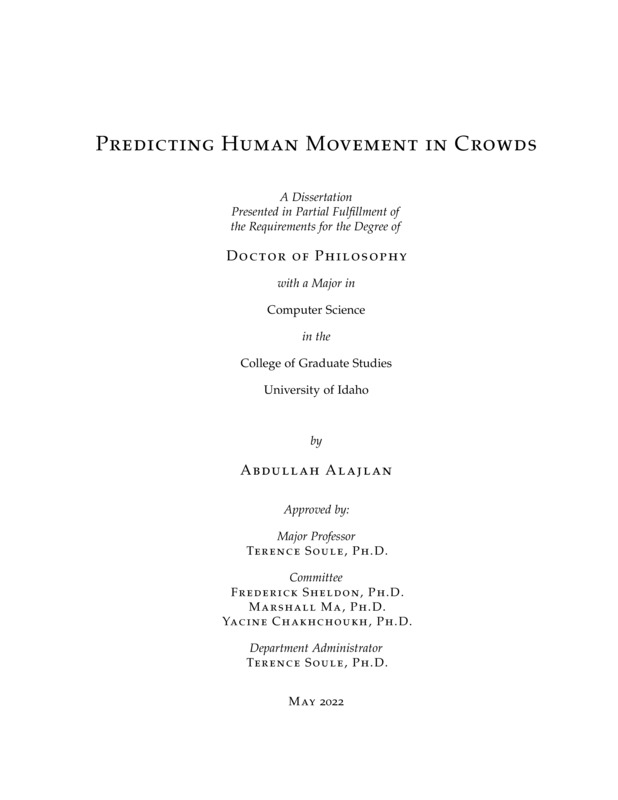Predicting Human Movement in Crowds
Alajlan, Abdullah. (2022-05). Predicting Human Movement in Crowds. Theses and Dissertations Collection, University of Idaho Library Digital Collections. https://www.lib.uidaho.edu/digital/etd/items/alajlan_idaho_0089e_12318.html
- Title:
- Predicting Human Movement in Crowds
- Author:
- Alajlan, Abdullah
- ORCID:
- 0000-0001-5188-5425
- Date:
- 2022-05
- Program:
- Computer Science
- Subject Category:
- Artificial intelligence
- Abstract:
-
The prediction of human movement when people gather in crowds for reasons has become very important for public safety and the protection of property. From the early 1990s different techniques have been studied to predict the next steps of individuals in crowds and the field of study has increased in rapidly as a result. Our research has developed along three lines of inquiry. First, we developed the use of a combination of genetic algorithms and neural networks (GA-NN) to predict individuals’ future steps in crowded areas. We applied a method, using a cone of vision of individuals to specify the location of the nearest people, in order to train the neural networks to accurately predict the decisions the individual agents would make based on their nearest neighbors. We demonstrated that using this combination of genetic algorithms and neural networks is effective at predicting movement in crowds. We also demonstrated that different physical layouts of areas and the difference in crowd types give different results when compared across experiments. Our crowd types included a structured crowd area and tan unstructured crowd area. We also introduced a new metric, the cumulative distance error (CDE) that is very effective in measuring prediction accuracy and can be used to improve experimentation in the field of human movement prediction.
Second, we tested the use of the long short-term memory (LSTM) using the similar methods that were used for the cone of vision calculations. It is known that recurrent neural networks (RNNs) and its sub-type LSTMs make use of memory and the past for training; we took the directions of the agent’s recent past steps, and the directions of other pedestrians in the field of view and predicted a sequence of future directions by taking the average speed as a constant speed in the future. We used three different layout styles, including structured crowds, unstructured crowds, and merging paths. We also used two different behaviors: the flocking model (FM) and the social force model (SFM). We compared our results with the LSTM method with the method described above that used the combination of genetic algorithms and neural networks. The results show that the LSTM outperforms the combination of genetic algorithms and neural networks in both simulations, and for every dataset.
In the third line of inquiry, we expanded our work to include more scenarios, more types of crowds, and a longer distance for prediction. For example, intersections, waypoints, and more complicated unstructured crowded areas have been included in this line of inquiry. Additionally, we extended the predictions from five time-steps up to fifty time-steps in certain situations. The results show that we should differentiate between crowd types in predictions because the results depend on the crowd types, and layout styles.
- Description:
- doctoral, Ph.D., Computer Science -- University of Idaho - College of Graduate Studies, 2022-05
- Major Professor:
- Soule, Terence
- Committee:
- Sheldon, Frederick; Ma, Marshall; Chakhchoukh, Yacine
- Defense Date:
- 2022-05
- Identifier:
- Alajlan_idaho_0089E_12318
- Type:
- Text
- Format Original:
- Format:
- application/pdf
- Rights:
- In Copyright - Educational Use Permitted. For more information, please contact University of Idaho Library Special Collections and Archives Department at libspec@uidaho.edu.
- Standardized Rights:
- http://rightsstatements.org/vocab/InC-EDU/1.0/

